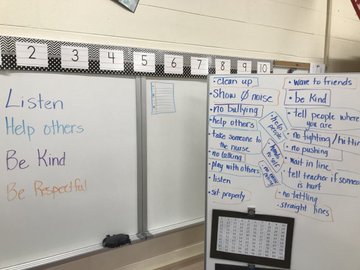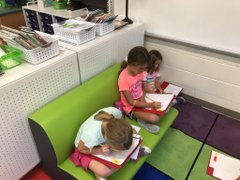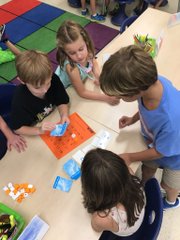This blog is meant to provide parents with details about the time in our classroom (with pictures!). I will provide you with an explanation of each content area, as well as ways you can help at home.
Please feel free to ask if you have any questions!

Social Studies:
In social studies, we discussed ways to be a super citizen. We broadened this idea to other content areas the past few weeks (being a super citizen in math, reading and writing workshop)! Students were able to clearly explain how they could be a super citizen of our classroom community, school community, city community, national community, and global community.
Students spoke about different rules people have to obey. We came to the conclusion that we have rules in the classroom and those rules should transfer to all areas of our lives.
We learned about Cesar Chavez. He was a Mexican American who fought for equality in the state of California. He founded the National Farm Worker's Association, which helped earn farm workers higher wages and better working conditions.


Ways to help at home:
- When taking a family walk, pick up trash and talk about how super citizens help the community become a better place to live, work and play.
- If you are driving, discuss the different laws you have to obey (stopping at a stop sign, driving the speed limit, etc.).
Reading:
We began this week by learning to choose a "just right" book. We watched the story of Goldilocks and how she needed to have "just right" porridge and a "just right" bed. Reading is very similar because we can't have books that are too hard or too easy. We have to find "just right" books as well. We talked about finding books that are of interest, that they can comprehend, and that they know how to read. At this time, students are only allowed to choose books from certain bins (easier books). I will open up other bins and genres after I am able to more formally assess them. I already know a few students who are either above or below the bins that are available to students, so my hope is to assess those students first so they can get into more "just right" books quickly and don't get bored or frustrated.
This week, students were asked to think of themselves as readers (how do they like to read, with whom do they like to read, and who are model readers they want to be like). Students answered a survey, drew pictures, and wrote about their reflection as a reader.
We spent quite a bit of time talking and reflecting on reading and were able to make it about 12 minutes of straight reading before several students got bored and started looking around. At that time, we moved around and started again. Eventually, students will get to the point where they can read for 30-40 minutes straight and will get cranky when I tell them it's time to clean up! :)

Ways to help at home:
- The hardest part about reading at home is that you don't know if a book is a "just right" book. If your child has a book that you aren't sure is a good fit, ask them to read a page or two to you. If there are more than 5 words that your child does not know, the book is "too big." If your child can read it, but doesn't really know what it means, it is only a little "too big."
- Don't feel that your child is ever too old to read a book together. Children learn through your modeling! Have your child read to you, share the book and each of you read a page, or you read to your child if the book is "too big." All of these are wonderful ways to spend quality time with your child.
Writing:
Writing this week has included me reading books so that we can make lists of "things to write about" for idea generation. Students made a list of who they could write about, places they could write about, favorite things they could write about, and experiences they could write about. I did have a few students who got stuck when writing, so I pulled out my story dice app and they were able to get some ideas!
We have about 10 minutes between specials and lunch, so students spend about 5-10 minutes each day practicing their handwriting while listening to calming music. During this time, they focus on exactly where their letters should begin and end. I am amazed at the quality that I get during this time! This will eventually transition to cursive!



Ways to help at home:
Students can write at home. They could help you with the grocery list, write a letter to family or friends, or just write a creative story. There are two great apps you can get for your phone (Name Dice and Story Dice by Thinkamingo) that will help when they are stuck. The Name Dice pops up 2 names at a time and the Story Dice shows 2 or 3 pictures that generate a "situation" that students can write about. I only allow students to tap it 3 times for ideas or they might get carried away with tapping and not actually thinking about what the picture on the dice could do for their story.
Word Study:
We have yet to start word study. We will begin in two weeks. All students will begin with the same sort (sight words) and learn different activities we will use over the school year. We will then begin words that are determined by where each student is with word study.
Ways to help at home:
- Ask your child to spell easy, commonly used words when you are writing a note or a list. Remember that words we think are easy (like was or one or what) can be challenging for them because was sounds like it should be spelled wuz. Choose words that can easily be sounded out.
- I will be teaching students a strategy for harder words. I ask students to count the sounds for the word. If we are spelling stamp, there are sounds, so we draw 5 lines, like this _ _ _ _ _. Then we begin filling in the lines with the sounds we hear.
s _ _ _ _ then
s t _ _ _ then
s t a _ _ then
s t a m _ then
s t a m p
I explain that this might not be exactly how to spell the word, but it would be super close! For instance, sneak might become sneke or even just snek. From this point, students who can then use what they know from word study to get even closer. If they have had the long e sort with ea, then they know they could put an ea on the third line. If they know that some long e sounds at the end of a word will end with an i, ie or y. They can then add them and see which one looks familiar. Ask your child to use this strategy at home. We will be learning it in a week, but as the year progresses, students will become very good at it.
Math:
The first unit of study is simply seeing what they know, reviewing helpful tools (hundreds chart, number line, etc), introducing games, and simply understanding how the math workshop will flow. This past few weeks, we have used the hundreds chart to count AND solve simple addition and subtraction problems, began skip counting, identified and counted coins, and solved simple word problems together. Our biggest focus was making sure students could count 100 objects. We talked about different strategies, such as counting by twos and placing them in lines of 10 so that anytime I walked up and asked how many they had counted, they would easily be able to tell me. We used colored cubes so they could count ten of each color, as in the pictures below. We also reviewed the identification of coins, their value, and counting them (using cubes as a backup counter). Most students were were successful with both of these tasks, but practice makes perfect. Below are ways to help your child grow as mathematicians.





Ways to help at home:
- Pull out 100+ pennies or beans or... and ask your child to count them. Students should remember to place them in groups of 10 so they can easily figure out what number they are on should they get confused.
- Ask your child to identify different coins, count a handful of change, and make $1.00 with different coins.
----------------------------------------------------------------------------------------------------------------
Don't forget to come to Back-to-School Night! On Tuesday, September 11th, come in to hear about a day in the life of your second grader. In the past, there has been a "State of the School address" by our Principals, but it will be slightly different this year.
Schedule:
6:00 - Come to the classroom and hear Mr. Crutchfield welcome you to Brownsville. PTO will share a quick video about the work they will do this year.
6:10 - Session 1 begins - I will talk to you about what you can expect this year, how we manage in the classroom each day, and answer any questions you might have.
6:40 - Session 1 ends - please be sure to see your child's artwork in the hallway!
6:50 - Session 2 begins - Again, I will talk to you about what you can expect this year, how we manage in the classroom each day, and answer any questions you might have. This is the exact same as the first session.
7:30 - Session 2 ends - please be sure to see your child's artwork in the hallway!
Two reminders
1. This is a night for parents only. Parents are asked to leave their children at home, if possible.
2. This is an informational session and not a conference. If you would like to talk with me about your child's specific needs, please send me an email to set up a conference. Please be mindful of my time during this informational evening.
No comments:
Post a Comment